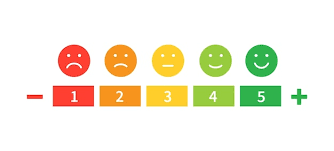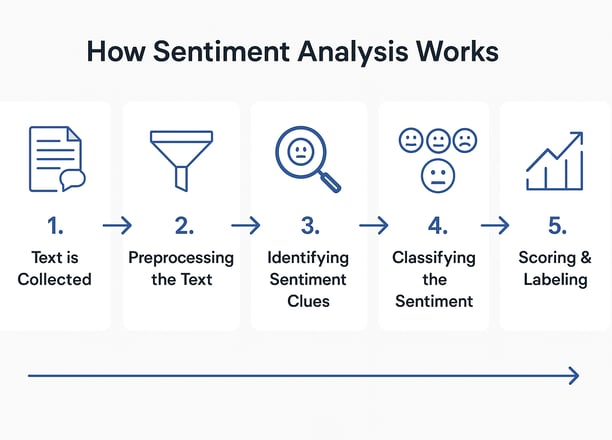Sentiment Analysis
In a world full of opinions, your brand’s success depends on how well you listen and respond to customer emotions. At LabelCo.Ai, we help machines understand human feelings—whether it's joy, frustration, sarcasm, or confusion—by accurately labeling emotional cues hidden in text, chats, reviews, and social media posts.
Our sentiment analysis services give your AI models the power to analyze customer feedback at scale and respond in real time.
What is Sentiment Analysis?
Sentiment analysis is like teaching a computer to understand how people feel. By analyzing the tone and emotion behind messages, reviews, or tweets, your AI can detect whether people are happy, upset, neutral—or something in between.
We help AI models classify text into positive, negative, or neutral sentiments, while also tagging emotions like anger, satisfaction, or curiosity.
Why Choose LabelCo.Ai?
100% Human-Verified Sentiment Tagging
Domain Expertise Across Industries
Tool & Platform Flexibility (Client Tools or LabelCo Platform)
Real-Time Dashboards & QA Monitoring
Data Privacy & Security Assured


150+
250+
Annotators Onboarded
Happy clients
Importance of Sentiment Analysis
Sentiment analysis enables businesses to quickly track what people are saying about them online and categorize that feedback as positive, negative, or neutral. This insight helps brands evaluate the impact of marketing and PR efforts, enhance customer support, and identify which product or service features resonate most—so they can build on what works.
Understand Customer Emotions at Scale


Sentiment analysis helps decode how customers feel about your brand, products, or services by analyzing large volumes of text automatically.




Protect and Enhance Brand Image
By monitoring feedback across platforms, businesses can spot negative sentiments early and respond before issues escalate.
Emotional data enables teams to tailor marketing, improve support, and shape better products based on how people actually feel.
Make Smarter Business Decisions
Our 6-Step Process


3. Identifying Sentiment Clues
Using AI models or rule-based algorithms, the system analyzes Words (e.g., “love” is positive, “hate” is negative), Phrases (e.g., “not good” is negative, even though “good” is a positive word), Context (e.g., detecting sarcasm or mixed emotions), Emojis or punctuation (e.g., “Awesome!!! 😍” = clearly positive)
4. Classifying the Sentiment
The AI then decides if the text is Positive (happy customers, praise), Negative (complaints, anger), Neutral (just informational, no emotion) Some advanced models even go beyond this and classify text into specific emotions like joy, sadness, frustration, or sarcasm.
2. Reprocessing the Data
Before we can teach the AI to understand emotion, we clean up the data by removing punctuation, emojis, and stopwords (like “the,” “and”), converting everything to lowercase, breaking down the sentences into words (called tokenization)
Each sentence or paragraph is given a sentiment score, usually between -1 and +1: +1 = Very Positive, 0 = Neutral, -1 = Very Negative. These scores and labels are then used to train AI models or provide real-time insights.
As your AI system gets more data and feedback, it keeps improving. Annotated data by human reviewers helps fine-tune the model for accuracy, industry-specific language, and local expressions.
5. Scoring & Labelling
6. Learning & Feedback
At LabelCo.Ai, our expert annotators and AI tools work together:
1. Text is Collected
The first step is to gather raw text from sources like Social media posts, Product reviews, Support tickets, Customer emails, News articles
Rule Based Sentiment Analysis
What it is: We use pre-set keywords, phrases, and logic rules to detect whether a sentence expresses a positive, negative, or neutral feeling.
Why it matters: It provides a fast and straightforward way to analyze sentiment, especially in short texts or surveys.
Where it’s used: Customer feedback forms, review monitoring, basic social media sentiment tracking.
Machine Learning Based Sentiment Analysis
What it is: Our AI models are trained on large sets of labeled data to recognize emotional tones—even in complex or sarcastic sentences.
Why it matters: This method improves accuracy over time and adapts to language variations and context.
Where it’s used: Chatbots, support ticket analysis, brand monitoring, financial sentiment from news.




Hybrid Sentiment Analysis
What it is: We combine rule-based systems with machine learning for the best of both worlds—speed and adaptability.
Why it matters: It balances precision and scale, ideal for large projects that require consistency and intelligence.
Where it’s used: Enterprise-level analytics, multi-language customer experience platforms, political sentiment tracking.


Common Use Cases
1. Social Media Monitoring
Use Case:
Analyze tweets, Facebook comments, Reddit threads, or Instagram captions to understand public sentiment around your brand, campaigns, or events.
Benefit:
Detect PR crises early, track campaign success, monitor influencer impact, and understand brand health in real-time.
2. Product Reviews & E-commerce
Use Case:
Evaluate customer feedback on platforms like Amazon, Flipkart, or your own site to gauge satisfaction with specific products.
Benefit:
Spot issues, improve product descriptions, identify top-rated features, and prioritize updates based on actual customer emotions.
3. Customer Support & Chat Analysis
Use Case:
Monitor chat conversations, emails, or support tickets to identify negative tones or frustration in real time.
Benefit:
Automatically flag unhappy customers, prioritize escalations, and improve agent training and satisfaction scoring.
4. Market Research & Competitive Analysis
Use Case:
Compare sentiment around your brand vs competitors across forums, surveys, and social media.
Benefit:
Uncover what users love (or hate) about competing products and refine your messaging and strategy accordingly.
5. Healthcare & Patient Feedback
Use Case:
Analyze sentiment in patient surveys, reviews, and health forums to detect dissatisfaction, anxiety, or praise.
Benefit:
Improve patient care, highlight service gaps, and ensure more compassionate and responsive healthcare delivery.
6. Mental Health Monitoring
Use Case:
Use sentiment trends in messages, social media posts, or chatbots to assess emotional health and flag potential mental health risks.
Benefit:
Support early intervention efforts in mental wellness programs, digital therapy apps, or HR systems.
7. News & Public Opinion Analysis
Use Case:
Track how sentiment shifts in news articles or public reactions to global events, politics, or company announcements.
Benefit:
Power predictive analytics, political forecasting, stock market trends, and reputation management.
8. Surveys & Feedback Forms
Use Case:
Automatically classify open-ended survey responses (from employees, users, or customers) into positive, negative, or neutral categories.
Benefit:
Speed up data analysis and uncover actionable insights without manually reading thousands of responses.
Frequently asked questions
What kind of data can be analyzed for sentiment?
Answer:
We can analyze various types of text data including:
Social media posts
Product reviews
Support chats and emails
Survey responses
News articles and blog comments
Transcribed voice data
How accurate is your sentiment annotation?
Answer:
We combine AI-powered pre-tagging with human-in-the-loop review for accuracy levels up to 95–99%, especially in complex or domain-specific use cases.
Can LabelCo.Ai help train sentiment analysis models?
Answer:
Absolutely. We provide fully labeled datasets that can be used to train or fine-tune your sentiment detection models. We also assist in building domain-specific training data.
Does LabelCo.Ai support multilingual sentiment analysis?
Answer:
Yes, we support over 60+ languages, allowing us to annotate and detect sentiment in text data across global audiences.
LabelCo AI
Expert data annotation for AI and machine learning.
Contact
HELLO@labelco.ai
+91-9711151086
Get a custom quote for your annotation project
© 2025. All rights reserved.
